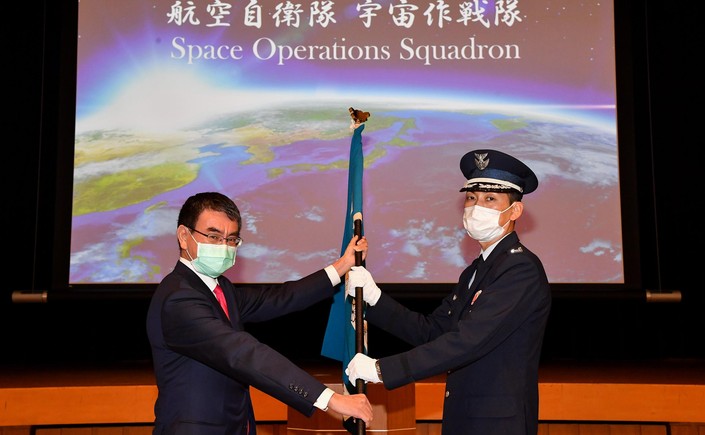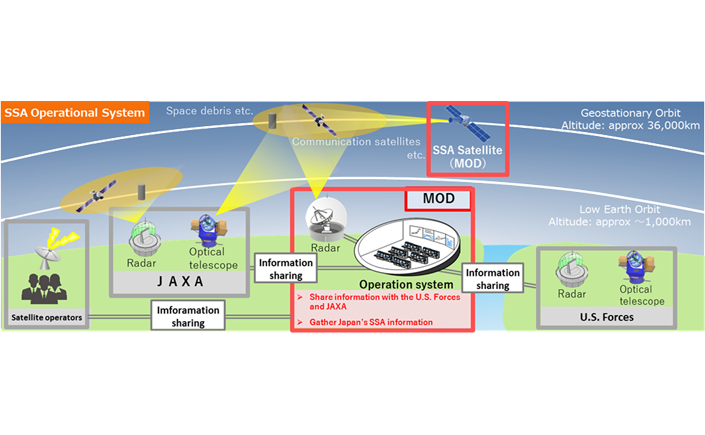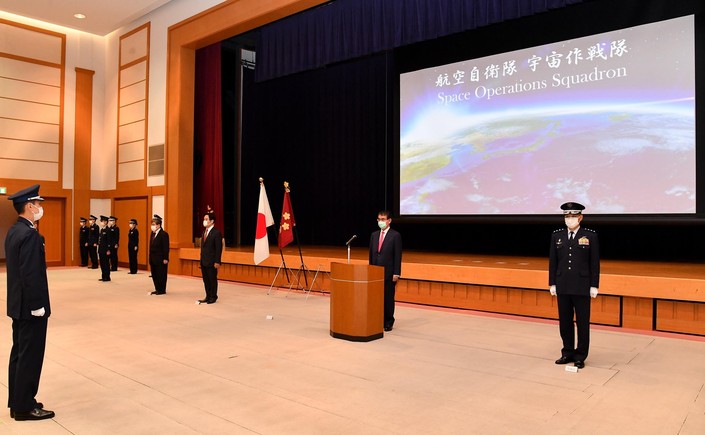SPECIAL FEATURE
Launch of the Space Operations Squadron
On May 18th, the squadron flag handover ceremony was held for the Space Operations Squadron, which was launched as the first space domain mission unit of the Japan Self-Defense Forces (JSDF), and Defense Minister Kono conferred the official flag of the squadron on its commander. Minister Kono conveyed words of encouragement to the squadron, stating “It is important that Japan ensures superiority in new domains, including space, as well as the land, sea and air. I ask the first commander to exert himself as a pioneer of the new domain, and live up to the great expectations and mandate from the public. And I ask the squadron personnel to work hard on your mission with great pride and morale.”
The Space Operations Squadron is composed of approx. 20 personnel, stationed at Fuchu Air Base. It has been launched with the main mission of operating the Space Situational Awareness (SSA) system, in order to monitor such things as space debris or suspicious satellites, which could pose a threat to Japanese satellites. With an eye to ensure Japan’s superiority in the space domain, the MOD/JSDF will keep reviewing the squadron’s operations in the space domain, nurture human resources with knowledge of the space domain, and build a system to cooperate with the United States, towards the start of a full-scale SSA operation from FY2023.
In the field of security in the space domain, military forces in major countries are actively involved in outer space activities and utilizing a variety of satellites. Major countries are making efforts to enhance the capabilities of various satellites and to launch them for the purpose of enhancing C4ISR functions (command, control, communication, computer, intelligence, surveillance, and reconnaissance). Such satellites include image acquisition satellites for reconnoitering military facilities and targets, early warning satellites for detecting the launch of ballistic missiles, satellites for gathering radio signals, communication satellites for communications between military units, and positioning satellites for navigating naval vessels and aircraft and enhancing the precision of weapons systems. In outer space, various countries are thus rapidly developing their capabilities to ensure their military superiority.
From the viewpoint of ensuring superiority in the space domain, there are movements that various countries are developing and improving their capabilities to impede each other’s use of outer space. For example, the ability to destroy a satellite with a ground-launched missile, or an anti-satellite weapon (ASAT) that does not directly hit and destroy a satellite with a missile, thus creating less space debris, are thought to have been developed. These ASATs under development include a “killer satellite” to approach a target satellite and utilize a robot arm to capture the target and disable its functions. Furthermore, it has been pointed out that not only missiles and killer satellites but also jammers for interfering with communications between target satellites and ground stations, and laser weapons for attacking target satellites with directed energy, are being developed.
As the above illustrates, the risk to the stable use of outer space has become one of the critical security challenges for countries, thus it has become necessary to deal with this risk effectively in an effort to ensure stability in the use of outer space.
Against this backdrop, countries are working on SSA by monitoring solar activity with a potential impact on satellites and electronic equipment on the Earth, and threats caused by meteors reaching the Earth, in addition to threats posed by anti-satellite weapons and space debris to space assets.
For the MOD/JSDF, the threat to the stable use of outer space is increasing. Based on the mid-term defense program, the MOD/JSDF will work to enhance capabilities to ensure superiority in use of space at all stages from peacetime to armed contingencies. The efforts include (1) establishing an SSA system in order to secure the stable use of space; (2) improving various capabilities that leverage space domain including information-gathering, communication and positioning capabilities, and; (3) building the capability to disrupt the C4I (command, control, communication, computer, and intelligence) of opponents with combined use of the electromagnetic domain. In so doing, the JSDF will (4) work to enhance cooperation with relevant agencies, including the Japan Aerospace Exploration Agency (JAXA), and with the United States and other relevant countries.
In line with these trends, the Space Operations Squadron has been launched as a specialized unit to operate the SSA system, and a specialty dedicated to the space domain has been newly established. At the squadron flag handover ceremony, representatives of the United States Space Command, U.S. Forces Japan, the Space Command of France (Commandement de l’Espace), the Royal Australian Air Force, the German Space Situational Awareness Center and JAXA also offered their congratulations.








